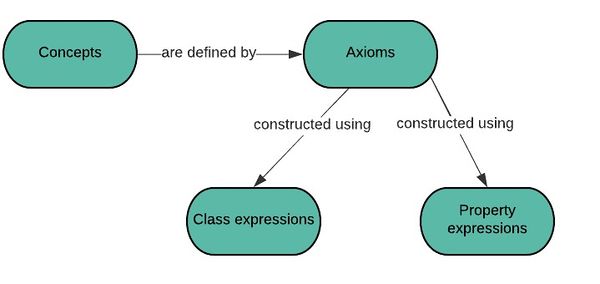Health Information modelling language - overview: Difference between revisions
DavidStables (talk | contribs) No edit summary |
DavidStables (talk | contribs) No edit summary |
||
| Line 17: | Line 17: | ||
The Ontology language describes four main structural types which cut across the information model content parts as described above, which are:[[File:Ontology.jpg|center|600x300px|Ontology.jpg]] | The Ontology language describes four main structural types which cut across the information model content parts as described above, which are:[[File:Ontology.jpg|center|600x300px|Ontology.jpg]] | ||
== Concepts classes and properties == | == Concepts classes and properties == | ||
[[Concepts_classes_and_properties|Concepts classes and properties]] form the building blocks used by the language and are declared in an ontology. | ''main article : ''[[Concepts_classes_and_properties|Concepts classes and properties]] form the building blocks used by the language and are declared in an ontology. | ||
| | ||
Revision as of 11:22, 6 May 2020
This article provides an outline of the Discovery information modelling language, used to provide a computable and readable information model.
The language is a single language but can be caregorised into the Discovery ontology language and a set of language elements that describe the data model, value sets and data sets
Ontology language
The ontology language is part of the Discovery information modelling language.
An ontology is concerned with the meaning of things and defines the meaning of things in a way that allows inferences to be made about other things. An ontology designed with a language such as OWL2 allows machines to make the sophisticated inferences required to support query and decision support. OWL2 itself is based on an underlying Description Logic variation which have underpinned machine reasoning for decades.
Ontologies have been used in health information systems for many years and more recently, the emergence of Snomed-CT as the de-facto health terminology has illustrated the potential power of description logic which underpins OWL.
Thus, the information model language used for the Discovery ontology is an OWL2 profile which lies between OWL EL and OWL DL.
Discovery implementation supports the official OWL2 functional syntaxe but also provides a simple JSON based syntax, “Discovery Syntax” which absorbs other language constructs for other parts of the model, and thus can also be used for the language of all of the IM components.
The Ontology language describes four main structural types which cut across the information model content parts as described above, which are:
Concepts classes and properties
main article : Concepts classes and properties form the building blocks used by the language and are declared in an ontology.
